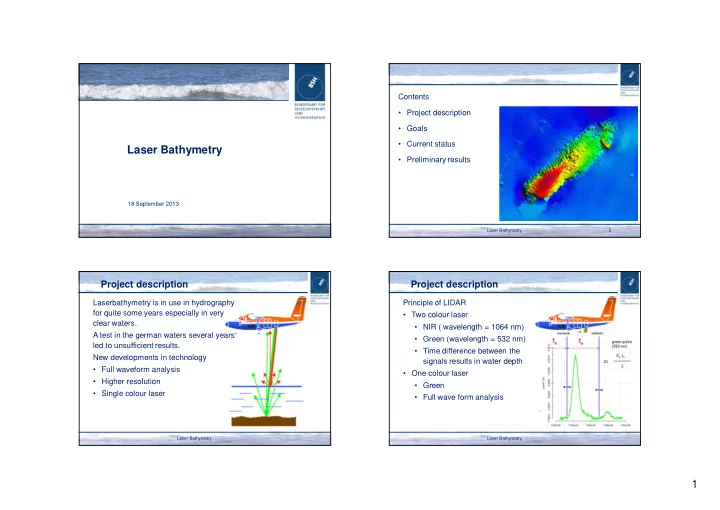

Contents • Project description • Goals • Current status Laser Bathymetry • Preliminary results 18 September 2013 Laser Bathymetry 2 Project description Project description Laserbathymetry is in use in hydrography Principle of LIDAR for quite some years especially in very • Two colour laser clear waters. • NIR ( wavelength = 1064 nm) A test in the german waters several years • Green (wavelength = 532 nm) led to unsufficient results. • Time difference between the New developments in technology signals results in water depth • Full waveform analysis • One colour laser • Higher resolution • Green • Single colour laser • Full wave form analysis Laser Bathymetry Laser Bathymetry 1
Project description Project description • Duration from 2012 to 2014; Technical aspects: • Contracted partner is the Leibnitz University in • Large footprints due to beam Hannover (IPI); divergence, • 3 independend flights (November 2012, September ½ water depth 2013, Spring 2014) • High resolution versus high • Comparison with regular surveys; penetration of water column • Associated partners support with their know-how; i.e. 138 kHz – 4 kHz • One test area; • Different operating heights. Laser Bathymetry Laser Bathymetry Project goals Project goals The main goals are (1) The main goals are (2) • To derive clear and detailed figures of the quality depending • To what extend objects can be detected on a.o.: • What are the maximum and minimum depth • Whether a coastline can be derived • visibility • To do a market survey • topography • How expensive is such a survey • sea floor conditions • time of year • weather conditions • influence of operating altitude Finally, to identify the areas in which that technology can be used economically, especially in cooperation with other agencies. Laser Bathymetry Laser Bathymetry 2
Current status Projekt Laserbathymetrie Test Site: • 345 m² • 4 overlapping areas • Different directions • Wrecks and obstructions • Waterdepth 0 to 20 m • Land area included • Rough topography • Boulders • different sea floor characteristics • Measured Secchi-depth Laser Bathymetry Trends in der Seevermessung Von der TKS zur GDI Current status Systems used Das Ergebnis ist ein Modell; A test site has been decided on. A first flight took place in November es beschreibt den 2012, where the system Riegl VQ-820G was used. Meeresboden und die Flight altitudes: Wattflächen gut trotz • Flights in 300, 400, 500, 600 and 700 meters Vertikallotungen; • Some limitations due to laser class Standardprodukt für die The next flight is scheduled for this month with AHAB Geodateninfrastruktur (GDI): Chiroptera and Hawk Eye II. Gittermodell 50m Raster umfasst jeweils die One more flight is planned for spring 2014. aktuellsten Vermessungen des BSH. Trends in der Seevermessung Laser Bathymetry Laser Bathymetry 3
Preliminary results Preliminary results LIDAR DTM Depth Difference information between LIDAR and regular survey Trends in der Seevermessung Laser Bathymetry Trends in der Seevermessung Laser Bathymetry Preliminary results Preliminary results DTM Density of depth information Difference between LIDAR and regular survey depth depth Std.Dev Mean Min Max area points % within % within depth Std.Dev mean 0-1 7.213.589 10,28 17,15 1 200 min [m] max [m] limits of limits of area [m] [m] Order 1 Order 2 1-2 5.072.351 9,89 11,57 1 158 2-3 4.657.428 10,02 12,28 1 147 0-1 0,37 0,20 -0,80 4,30 88,71 96,96 3-4 5.390.654 11,04 11,70 1 207 1-2 0,33 -0,03 -1,20 3,75 88,71 99,00 4-5 5.477.469 3,32 3,56 1 40 2-3 0,27 -0,12 -1,72 1,35 90,56 99,27 5-6 2.492.328 1,05 1,57 1 16 3-4 0,25 -0,15 -1,47 4,64 93,48 99,56 6-7 284.523 0,32 1,08 1 7 4-5 0,24 -0,26 -1,28 4,49 88,85 99,69 7-20 71.898 0,16 1,02 1 4 5-6 0,27 -0,30 -1,48 4,91 87,21 99,53 6-7 0,31 -0,29 -1,31 4,70 88,25 99,04 Mean: 3.832.530 5,76 7,49 1,00 97,38 7-20 0,49 -0,40 -2,93 2,43 84,27 95,51 Wrecks and obstructions? mean 0,32 -0,17 -1,52 3,82 89,90 99,17 Laser Bathymetry Laser Bathymetry 4
Preliminary results Preliminary results Density per m² The current findings are premature and can only give some hints. • Secchi depths 5-6 meters. A good resolution has been obtained down to this depth (5 points/m²). • Costs: depending on shape and size of the area, flight altitude and availability, in our case: roughly 300 to 350 €/km². • It seems to be very difficult to detect objects on the sea floor. • Anyway, for the investigated Western Baltic laser bathymetry can only be a supplement to the ship based hydrographic surveys in very shallow areas, where vessel operations are especially difficult. Trends in der Seevermessung Laser Bathymetry Laser Bathymetry Laser Bathymetry The Commission is invited to • take note of the report; Laser Bathymetry 5
Recommend
More recommend